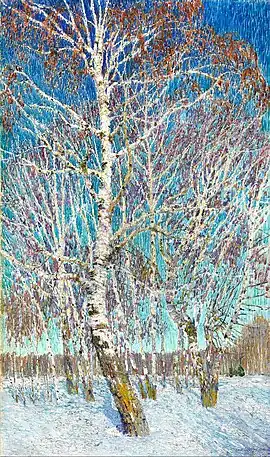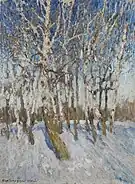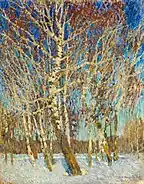| February Azure | |
|---|---|
| Russian: Февральская лазурь | |
 | |
| Artist | Igor Grabar |
| Year | 1904 |
| Medium | Oil on canvas |
| Dimensions | 142.6 cm × 84.8 cm (56.1 in × 33.4 in) |
| Location | Tretyakov Gallery, Moscow |
February Azure (Russian: Февральская лазурь, romanized: Fevral'skaya lazur'), also known as February Blue,[1] is a landscape painting by Russian post-impressionist painter Igor Grabar, created in 1904. The painting was presented to the public at the second exhibition of the Union of Russian Artists,[2] which opened on 31 December 1904 in Saint Petersburg and then moved to Moscow in February 1905.[3] In 1905, February Azure was purchased from Grabar by the Tretyakov Gallery in Moscow after a unanimous decision of the museum's board of directors.[4]
Grabar considered February Azure a sum of several separate, lengthy observations—in a sense, a synthesis of them—and a revolutionary work that opened up a new path Russian art had not explored until then.
Studies and background
At the first exhibition of the Union of Russian Artists in 1903, Grabar became acquainted with one of the participating artists, Nikolai Meshcherin.[5] Meshcherin invited Grabar to stay at his family estate on the bank of the Pakhra river in Moscow.[5] Grabar, being eager to paint snow and winter, accepted the invitation—he liked winter landscapes because he regarded snow as an ideal basis to use many different lighting effects on.[6] The Meshcherin family owned the Danilovskaya factory and were wealthy and hospitable.[5] Grabar felt home at their place. They provided him with a sleigh with a carriage to travel around the area for his studies.[5] During one of his usual wanderings near the estate in February 1904, he encountered "something extraordinary going on in nature. [...] a feast of azure skies, pearl birches, coral twigs, and sapphire shadows on the lilac snow", which impressed him deeply enough that he decided to embody it in a painting.[7]
Grabar first painted a study on a small canvas, then took a larger canvas and worked on another study for the next three days on the same spot.[10] Both studies survived: the first one, titled Winter, is stored in the collection of the State Russian Museum under the inventory number Ж-2219 in Saint Petersburg,[8] and the second, titled February Azure, is kept in the National Art Museum of Belarus in Minsk.[6][9]
Afterwards, he dug a trench more than one metre (3.3 ft) deep in the snow, in which he settled down with an easel and a canvas mounted on it so he could get an impression of "a low horizon and the celestial zenith, with all the gradations of blue from light-green below to ultramarine at the top".[11] He had prepared the canvas beforehand in the studio, covering it with a dense layer of lead white in varying tones.[11] The daily work lasted for two weeks, uninterrupted and entirely in situ.[12] Grabar recalled that, fortunately for him, the snow did not melt during the period as the weather stayed cold.[12] He worked under an umbrella, and with the front side of the canvas turned towards the sky so that the sunlight reflected on the snow did not fall on the painting—which would have affected his perception of the colours on it.[13][14]
Descriptions
The title describes the composition's essence effectively, as the painting depicts the intense colours of the sky on a cold February day.[17] Most of the painting's foreground is occupied by a birch tree with branches that are, according to art historian Olga Podobedova, "rhythmically arranged (ритмически расположенными)" and shining either white or golden against the sky background.[18] Grabar himself noted their rhythmic structure in his Automonograph.[19] The top of the tree cannot be seen as it is cut off by the upper edge of the canvas. Art historian Natalia Mamontova compared the branches to "wings" and observed that the red crowns of the trees are genuinely impressionistic,[5] whilst the painting's vertical format (142.6 cm × 84.8 cm or 56.1 in × 33.4 in)[20] heightens the plasticity of the birch and gives prominence to "the infinity of the azure space (бесконечность лазурного пространства)".[5] Behind are other, thinner birches, and on the horizon is a birch forest streaked with light in some distance. The snow in the foreground shows the shadows of the trees behind the viewer.[18]
Grabar wrote in his Automonograph that, although March Snow (Мартовский снег, 1904) seemed more popular among other artists than any other work he produced during his early years, he felt that February Azure was more significant and integral because it was a sum of several different, lengthy observations and, in a sense, a synthesis of them,[21] and believed that February Azure opened up a new path Russian art had not explored until then.[22]
See also
- Mir iskusstva – Early 20th-century Russian art movement with magazine of the same name
References
- ↑ Druzhinin, Serafim Nikolaevich (1955). The Tretyakov Gallery, a Short Guide. Foreign Languages Publishing House. p. 86. OCLC 4019473. Archived from the original on 19 July 2023. Retrieved 19 May 2023 – via Google Books.
- ↑ Lapshin, Vladimir Pavlovich (1974). Союз русских художников [Union of Russian Artists] (in Russian). Художник РСФСР. p. 48. Retrieved 19 May 2023 – via Internet Archive.
- ↑ Lapshin, Vladimir Pavlovich (1974). Союз русских художников [Union of Russian Artists] (in Russian). Художник РСФСР. p. 46. Retrieved 19 May 2023 – via Internet Archive.
- ↑ Grabar, Igor Emmanuilovich (1974). Письма 1891–1917 [Letters 1891–1917] (in Russian). Moscow: Наука. p. 161. Retrieved 19 May 2023 – via Internet Archive.
Совет ТретьяRовскои галереи единогласно купил у меня «Февральскую лазурь»
- 1 2 3 4 5 6 Mamontova, Natalia (2001). Игорь Грабарь [Igor Grabar] (in Russian). Moscow: Белый город. pp. 18–21. ISBN 5-7793-0359-2. Archived from the original on 19 July 2023. Retrieved 17 May 2023.
- 1 2 "февральская лазурь: Грабарь, Игорь Эммануилович" [February Azure: Grabar, Igor Emmanuilovich] (in Russian). National Art Museum of the Republic of Belarus. Archived from the original on 29 March 2023. Retrieved 17 May 2023.
Грабарь более всего любил писать зимние пейзажи, поскольку считал снег идеальной основой для многочисленных световых эффектов.
- ↑ Grabar, Igor Emmanuilovich (1937). Моя жизнь: автомонография [My Life: An Automonograph] (in Russian). Moscow: Искусство. p. 201. Archived from the original on 15 February 2023. Retrieved 17 May 2023 – via Boris Yeltsin Presidential Library.
Утром, как всегда, я вышел побродить вокруг усадьбы и понаблюдать. В природе творилось нечто необычайное, казалось, (...) праздник лазореного неба, жемчужных берез, коралловых веток и сапфировых теней на сиреневом снегу.
- 1 2 Serebryakova, N. Y. (2007). "О несостоявшемся даре музею русского искусства" [On the Failed Donation to the Museum of Russian Art]. Международная научнопрактическая конференция «Рериховское наследие»: Том III: Восток – Запад на берегах Невы [International Research and Practice Conference "Roerich's Heritage": Volume III: East-West on the Banks of the Neva] (PDF) (in Russian). Saint Petersburg: Saint Petersburg State University. pp. 73, 75. ISBN 9785810803072. Archived (PDF) from the original on 2 May 2023. Retrieved 18 May 2023.
- 1 2 Kruglov, Vladimir (2008). Игорь Грабарь (in Russian). Золотой век. p. 19. ISBN 978-5-342-00110-6. Archived from the original on 19 July 2023. Retrieved 19 May 2023 – via Google Books.
- ↑ Grabar, Igor Emmanuilovich (1937). Моя жизнь: автомонография [My Life: An Automonograph] (in Russian). Moscow: Искусство. p. 201. Archived from the original on 15 February 2023. Retrieved 19 May 2023 – via Boris Yeltsin Presidential Library.
(...) тотчас же побежал за небольшим холстом и в один сеанс набросал с натуры. Я эскиз будущей картины. На следующий день я взял другой холст и в течение трех дней написал етюд с того же места.
- 1 2 Grabar, Igor Emmanuilovich (1937). Моя жизнь: автомонография [My Life: An Automonograph] (in Russian). Moscow: Искусство. p. 201. Archived from the original on 15 February 2023. Retrieved 17 May 2023 – via Boris Yeltsin Presidential Library.
После этого я прорыя в глубоком снегу, свыше метра толщиной, траншею, в которой и поместился с мольбертом и большим холстом для того, чтобы получить впечатление низкого горизонта и небесного зенита, со всей градацией голубых-от светло-зеленого внизу до ультрамаринового наверху. (...) покрыв его по меловой, впитывающей масло поверхности густым слоем плотных свинцовых белил различных тональностей.
- 1 2 Grabar, Igor Emmanuilovich (1937). Моя жизнь: автомонография [My Life: An Automonograph] (in Russian). Moscow: Искусство. p. 201. Archived from the original on 15 February 2023. Retrieved 19 May 2023 – via Boris Yeltsin Presidential Library.
Ночью подмораживало, и снег не сдавал. (...) и мне посчастливилось писать подряд без перерыва и перемены погоды около двух с лишним недель, пока я не кончил картину целиком на натуре.
- ↑ Podobedova, Olga Ilyinichna (1964). Игорь Эммануилович Грабарь [Igor Emmanuilovich Grabar] (in Russian). Советский художник. p. 95. Archived from the original on 19 July 2023. Retrieved 17 May 2023 – via Google Books.
Писал художник с зонтиком, окрашенным в голубой цвет, и холст поставил не только без обычного наклона вперед, (...) но повернув его лицевой стороной к синеве неба. отчего на него не падали рефлексы от горячего под солнцем снега. и он оставался в холодной тени.
- ↑ Grabar, Igor Emmanuilovich (1937). Моя жизнь: автомонография [My Life: An Automonograph] (in Russian). Moscow: Искусство. p. 201. Archived from the original on 15 February 2023. Retrieved 19 May 2023 – via Boris Yeltsin Presidential Library.
Писал я с зонтиком, окрашенным в голубой цвет н холст поставил не только без обычного наклона вперед, лицом к земле, но повернув его лицевой стороной к синеве неба, отчег на него не падали рефмексы от горячего под солнцем снега (...) вынуждая меня утраивать силу цвета для передачи полноты впечатления.
- ↑ Ryzhkova, Tatiana (19 November 2022). "Грабарь как он есть: яркая выставка в Третьяковке, на которую надо сходить" [Grabar as he is: a vivid exhibition at the Tretyakov Gallery you should visit] (in Russian). RIA Novosti. Archived from the original on 29 March 2023. Retrieved 19 May 2023.
в экспозиции представлены две самые известные картины Грабаря-импрессиониста: зимние и весенние березы — "Февральская лазурь" и (...)
- ↑ "Игорь Грабарь. К 150-летию со дня рождения" [Igor Grabar. On the 150th anniversary of his birth]. Музеи России [Museum of Russia] (in Russian). Archived from the original on 29 March 2023. Retrieved 19 May 2023.
- ↑ Tkach, Mikhail Ivanovich (2002). Энциклопедия пейзажа [Encyclopedia of Landscapes] (in Russian). Олма-Пресс Образование. p. 112. ISBN 9785948491363. Retrieved 18 May 2023 – via Google Books.
Поэтичное название полотна отражало сущность композиции художник показал пронзительную чистоту синего февальского неба, прозрачность холодного дня.
- 1 2 Podobedova, Olga Ilyinichna (1964). Игорь Эммануилович Грабарь [Igor Emmanuilovich Grabar] (in Russian). Советский художник. p. 95. OCLC 490504892. Archived from the original on 19 July 2023. Retrieved 17 May 2023 – via Google Books.
(...) сияющих то белизной, то золотом на фоне весеннего неба берез. Главная героиня картины - береза с ритмически расположенными ветвями как бы закрывает от зрителя расположенные купами по две. (...) где на горизонте виднеется прозрачный. свободный от листвы и пронизанный светом березовый лес.
- ↑ Grabar, Igor Emmanuilovich (1937). Моя жизнь: автомонография [My Life: An Automonograph] (in Russian). Moscow: Искусство. p. 201. Archived from the original on 15 February 2023. Retrieved 19 May 2023 – via Boris Yeltsin Presidential Library.
Я стоял около дивного экземпляра березы, редкостного по ритмическому строению ветвей.
- ↑ Атрощенко, Ольга (2022). "«Мне нужно только искусство, искусство и больше ничего» Выставка Игоря Грабаря к 150-летию со дня рождения" ['I need only art, art and nothing else' Igor Grabar exhibition for the 150th anniversary of his birth]. Журнал "Третьяковская галерея" [Tretyakov Gallery Magazine] (in Russian). Vol. 3, no. 76. Moscow: Государственная Третьяковская галерея (Tretyakov Gallery). p. 13. ISSN 1729-7621. Archived from the original on 9 May 2023. Retrieved 21 September 2023.
- ↑ Grabar, Igor Emmanuilovich. "Автомонография Игоря Грабаря стр.6" [Igor Grabar's Automonograph p.6]. igor-grabar.ru (in Russian). Archived from the original on 15 August 2022. Retrieved 18 May 2023.
"Мартовский снег" понравился, помнится, художникам больше всех других моих тогдашних вещей, (...) Мне тогда казалось, что "Февральская лазурь" значительнее и цельнее этой вещи, (...) а суммой длительных и неповерхностных наблюдений, и в известном смысле их синтезом.
- ↑ Grabar, Igor Emmanuilovich. "Автомонография Игоря Грабаря стр.6" [Igor Grabar's Automonograph p.6]. igor-grabar.ru (in Russian). Archived from the original on 15 August 2022. Retrieved 18 May 2023.
(...) "Февральская лазурь" открывала новый путь, в тогдашнем русском искусстве еще неизведанный.
External links
 Media related to February azure by Igor Grabar at Wikimedia Commons
Media related to February azure by Igor Grabar at Wikimedia Commons


